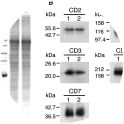Anti-CD3, Recombinant [UCH-T1®]
Invented by Prof Peter Beverley from Imperial College
Invented at Cancer Research UK London Research Institute: Lincoln's Inn Fields
- Datasheet
- References (2)
- Inventor Info
Info
| Catalogue Number | 152589 |
| Applications | FACS WB |
| Antigen/Gene or Protein Targets | CD3 |
| Reactivity | Human |
| Relevance |
Recombinant version of CRT trademarked famous anti-CD3 monoclonal antibody, capable of differentiating between T vs B cells lymphomas and leukaemia’s. Background and Research Application The CD3 complex, composed of four distinct CD3 polypeptide chains ( CD3γ, CD3δ and 2X CD3Ɛ), associates with the T cell antigen receptor (TCR). It is found on all mature human T lymphocytes, NK cells and some thymocytes. CD3 is a member of the immunoglobulin superfamily, involved in antigen recognition, T lymphocyte activation and signal transduction. This is a recombinant version of anti-CD3 UCH-T1 . UCH-T1 is considered a pan T-cell marker - it can be used for the detection of T cell populations in peripheral blood and lymph nodes and the categorisation of T versus B cell lymphomas and leukaemia’s. It reacts with the majority of peripheral blood T lymphocytes, a major proportion of thymocytes, the majority of T cell chronic lymphocytic leukaemia cells, Sézary leukaemia’s and approximately 70% of acute lymphoblastic leukaemia’s of T cell origin. It can also be used to study the role of CD3 in TCR signal transduction events. This antibody was created by Professor Peter Beverley, a pioneer in creating hybridomas from mice immunised against human lymphocytes, with UCHT1 being one of the first successful fusions. |
| Host | Mouse |
| Immunogen | Human infant thymocytes and Sezary cells. |
| Subclass | IgG1 |
| Formulation | PBS only |
| Concentration | 1mg/ml |
| Research Area | Cancer, Cell Type or Organelle Marker, Cell Signaling & Signal Transduction, Immunology, Stem Cell Biology |
| Immunogen UniProt ID | P04234 |
| Notes |
Production Details Purified using multi-step affinity chromatography with protein A. Storage Conditions Store at -20 degrees frozen. Avoid repeated freeze/thaw cycles. Points of Interest UCHT1 binds to an acidic region of CD3-epsilon, occluding this region form direct interaction with the T cell receptor. UCHT1 readily detects T-cell populations, in peripheral blood and lymph nodes, as CD3 is present on around 68-82% of healthy peripheral blood lymphocytes. Recommended for the enrichment of T cell populations by cell sorting or panning. Recombinant monoclonal antibody produced from the original monoclonal. Manufactured using Absolute Antibody’s Recombinant Platform with variable regions (i.e. specificity) from the hybridoma. Concentration 1mg/ml as standard |
References: 2 entries
Original hybridoma first published in: Beverley et al. 1981. Eur J Immunol. 11(4):329-34. PMID: 6788570.
Distinctive functional characteristics of human "T" lymphocytes defined by E rosetting or a monoclonal anti-T cell antibody.
Europe PMC ID: 6788570
Add a reference
References: 2 entries
Original hybridoma first published in: Beverley et al. 1981. Eur J Immunol. 11(4):329-34. PMID: 6788570.
Distinctive functional characteristics of human "T" lymphocytes defined by E rosetting or a monoclonal anti-T cell antibody.
Add a reference



![Western Blot staining of Jurkat (A) and Molt4 (B) lysates (35 µg protein in RIPA buffer) using anti-CD3, Recombinant [UCH-T1] (3 µg/ml) . Primary incubation was 1 hour. Detected by chemiluminescence.](https://res.cloudinary.com/ximbio/image/upload/c_limit,fl_lossy,h_282,q_auto,w_368/51321c28-b4ee-4349-b343-80116d413e0e.jpg)
![Image thumbnail for Anti-CD3, Recombinant [UCH-T1<sup>®</sup>]](https://res.cloudinary.com/ximbio/image/upload/c_fit,fl_lossy,q_auto/c0279675-6c38-4a33-a4d6-b011a19383c6.jpg)
![Image thumbnail for Anti-CD3, Recombinant [UCH-T1<sup>®</sup>]](https://res.cloudinary.com/ximbio/image/upload/c_fit,fl_lossy,q_auto/51321c28-b4ee-4349-b343-80116d413e0e.jpg)
![Image thumbnail for Anti-CD3, Recombinant [UCH-T1<sup>®</sup>]](https://res.cloudinary.com/ximbio/image/upload/c_fit,fl_lossy,h_45,q_auto/c0279675-6c38-4a33-a4d6-b011a19383c6.jpg)
![Image thumbnail for Anti-CD3, Recombinant [UCH-T1<sup>®</sup>]](https://res.cloudinary.com/ximbio/image/upload/c_fit,fl_lossy,h_45,q_auto/51321c28-b4ee-4349-b343-80116d413e0e.jpg)



